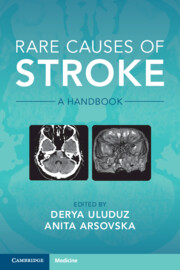Book contents
- Rare Causes of Stroke
- Rare Causes of Stroke
- Copyright page
- Contents
- Contributors
- Preface
- 1 Inflammatory Conditions
- Chapter 1.1 Isolated Vasculitis of the Central Nervous System
- Chapter 1.2 Primary Systemic Vasculitis
- Chapter 1.3 Vasculitis Secondary to Systemic Disease
- Chapter 1.3 Chapter
- 2 Infectious and Postinfectious Vasculitis
- 3 Hypercoagulable Causes of Stroke
- 4 Drug-Related Stroke
- 5 Hereditary and Genetic Causes of Stroke
- 6 Rare Causes of Cardioembolism
- 7 Vasospastic Conditions and Other Vasculopathies
- 8 Other Non-inflammatory Vasculopathies
- 9 Venous Occlusive Conditions
- 10 Bone Disorders and Stroke
- Index
- References
Chapter 1.3 - Chapter
from 1 - Inflammatory Conditions
Published online by Cambridge University Press: 06 October 2022
- Rare Causes of Stroke
- Rare Causes of Stroke
- Copyright page
- Contents
- Contributors
- Preface
- 1 Inflammatory Conditions
- Chapter 1.1 Isolated Vasculitis of the Central Nervous System
- Chapter 1.2 Primary Systemic Vasculitis
- Chapter 1.3 Vasculitis Secondary to Systemic Disease
- Chapter 1.3 Chapter
- 2 Infectious and Postinfectious Vasculitis
- 3 Hypercoagulable Causes of Stroke
- 4 Drug-Related Stroke
- 5 Hereditary and Genetic Causes of Stroke
- 6 Rare Causes of Cardioembolism
- 7 Vasospastic Conditions and Other Vasculopathies
- 8 Other Non-inflammatory Vasculopathies
- 9 Venous Occlusive Conditions
- 10 Bone Disorders and Stroke
- Index
- References
Summary
Cerebral Amyloid Angiopathy-related inflammation (CAA-ri) is a rare and sometimes aggressive autoimmune encephalopathy caused by immune reaction directed to the beta-amyloid protein in cerebral small vessels. It has been described in the main cerebral amyloid-related diseases, cerebral amyloid angiopathy (CAA) and Alzheimer’s Disease (AD) as a spontaneous occurrence and a phenomenon triggered by immunological therapy in recent trials for AD. Indeed there are several similarities between the clinic-radiological syndrome described in CAA (CAA-ri) and the neuroradiological phenomenon described in AD patients as Amyloid-Related Imaging Abnormalities (ARIA). CAA-ri is probably underdiagnosed because many CAA patients are elderly and cognitively impaired before CAA-ri occurrence. In some cases a missed diagnosis means a missed possibility of treatment because in its most striking form it is known as steroid-responsive dementia. The clinical expression of CAA-ri is characterized by the acute/subacute onset of neurological symptoms, accompanied by the neuroimaging evidence of cerebral vasogenic edema on FLAIR-MR sequences, and cortical-subcortical microbleeds (MBs) and/or cortical superficial siderosis (CSS) on T2*-weighted gradient echo (T2*-GRE) or susceptibility weighted imaging (SWI). CSS is a marker of CAA included in modified Boston criteria for CAA diagnosis and it represents a neuroradiological sign highly specific of CAA and associated to an even higher ICH risk than MBs. Atypical forms of CAA-RI have also been reported including radiologically isolated CAA-ri, minimally symptomatic CAA-RI, CAA-RI with isolated leptomeningitis, and CAA-RI without MBs. There is a well-defined set of clinic-radiological criteria, validated vs hysto-pathological examination with a sensitivity of 82% and a specificity of 97% for the category of probable CAA-ri. The main differential diagnosis is represented by neoplastic, infectious, or other even more rare causes
Keywords
- Type
- Chapter
- Information
- Rare Causes of StrokeA Handbook, pp. 99 - 106Publisher: Cambridge University PressPrint publication year: 2022

